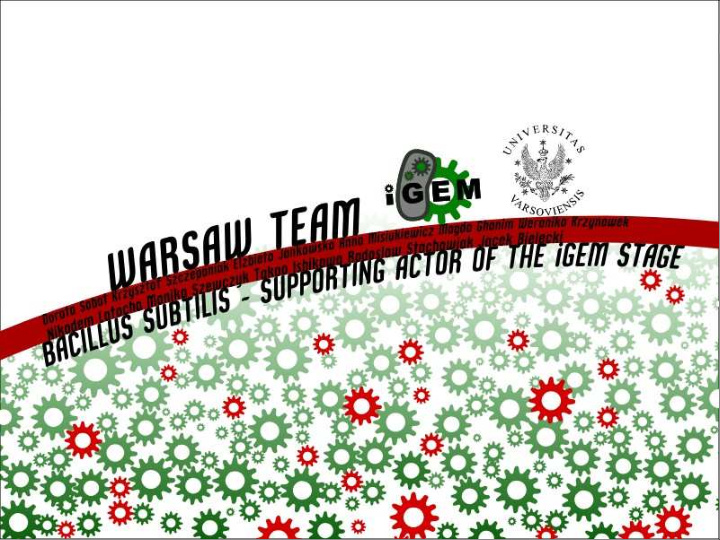



STAGE SETTING (OR AIMS OF OUR PROJECT) ● Create carrier bacteria able to deliver chosen genes into eukaryotic cell ● Bacteria enter the eukaryotic cell, then decompose and release plasmid that is used by the cell to produce given protein ● The ability of entering eukaryotic cells is introduced from invasive bacteria to a safe non-pathogenic strain
STARRING: BACILLUS SUBTILIS ● A model gram-positive bacteria used in synthetic biology ● Only a few BioBricks available for it ● Very interesting and challenging field ● We aimed at creating more BioBricks for Bacillus subtilis which would encourage more teams to working with it
WHY BACILLUS SUBTILIS WAS GIVEN THE LEADING ROLE? ● The model bacterium of synthetic biology, Escherichia coli , is gram-negative ● Listeria monocytogenes, which produces listeriolysin is a gram-positive bacterium ● Differences in gene expression and protein function between gram-negative and gram-positive bacteria ● Listeriolysin has better performance in gram-positive bacterium
THE REST OF THE CAST;)
SCREENPLAY ● Creating B. subtilis strain able to enter eukaryotic cells ● Creating a mammalian vector capable of replication and gene expression inside eukaryotic cell ● Creating a shuttle vector which would work in both procaryotic and eukaryotic cells
SCREENPLAY - FIRST ACT (1) The bacteria carrying invasion vector would enter eukaryotic cells via phagocytosis
– SCREENPLAY FIRST ACT (2) Due to lysteriolysin activity it would escape from the phagosome before destruction (3) GFP fluorescence would be used to determine if bacteria successfully entered the cytoplasm
SCREENPLAY - SECOND ACT (4) Lysis of B. subtilis cells would release the mammalian vector into the cytoplasm Due to oriP and EBNA1 gene the DNA molecule would replicate and genes present on it would be expressed
SCREENPLAY - SECOND ACT (5) Measurement of fluorescent activity to confirm success
SAFETY ON STAGE ● Due to safety measures, we did not plan to combine the two parts of our experiment. Each of the systems would be tested separately ● In the future, when the safety issues are solved, the device could be a great help in gene therapy
SCREENPLAY - THE FINAL ACT ● The shuttle vector would work both in eukaryotic and bacterial cells ● RFP flurescence measurement would prove its presence, replication and expression in eukaryotic cells ● GFP would prove it is present in bacterial cells
MAKING OF THE MOVIE Parts we cerated for B. subtilis : ● Promoter : BBa_K780003 ● RBSes : BBa_K780001 and BBa_K780002 ● Terminator : BBa_K780000
MAKING OF THE BRICKS ● We used a technique called primer annealing and extension
CHARACTERISATION OF NEW PARTS ● We measured strength of K780002 RBS in E. coli relative to B0034 RBS
BUILDING OUR CONSTRUCTS ● Construct for B. subtilis ● Built on pTG262
● Mammalian construct
● Shuttle vector
OUR PRESENT RESULTS ● New promoter for B. subtilis ● Two new RBSes for B. subtilis ● New terminator for B. subtilis ● All our parts could probably work in E. coli ● One characterised RBS, measured in E. coli ● We didn't manage to confirm all our constructs by sequencing, and we didn't want to send iGEM HQ parts we weren't sure of
● We couldn't successfully transform Bacillus subtilis with our constructs, so unfortunately we didn't manage to end our project... ● We are sure that if we had more time and better procedure of transformation we could end our project successfully!
HAPPY END ● In the future, when the safety problem will have been solved this method could be used to provide genes to human cells with faulty genes ● Example – phenylketonuria is a disease caused by a defunct gene coding hepatic enzyme phenylalanine hydroxylase, making it nonfunctional
BIOLOGISTS' NIGHT An event in which many Polish universities are taking part The main audience are high school students interested in biology Our Team educated young people about synthetic biology and the iGEM project
'NUMBERS, COMPUTERS, LIFE' Organized by Jagiellonian University in Kraków Members of our team prepared and gave a presentation about basics of synthetic biology and the iGEM competition One of the students we met there became a member of our team:)
WE PUT 'HUMAN' IN 'HUMAN PRACTICE';)
2ND INTERNATIONAL SCIENTIFIC SEMINAR 'SCIENCE- SOCIETY-DIDACTICS' An event organized by Pedagogical University of Kraków, aimed at educating life sciences teachers about different approaches to biology Our advisor gave a presentation about novel approach to synthetic biology and the iGEM project
The audience at every event was very interested in science, synthetic biology and the iGEM project itself. Their enthusiasm helped us during bad times in lab when nothing was working as planned:P
OUR SPONSORS
OUR SPECIAL THANKS GO TO: ● Edinburgh Team, for sending us the pTG262 plasmid ● Slovenia Team, for sending us the CMV promoter
THANK YOU FOR YOUR ATTENTION!
Recommend
More recommend